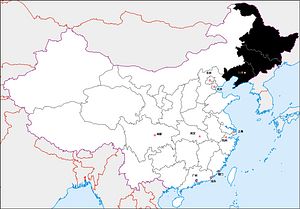This article series explores 12 distinct “regions” within China: six “core” regions long dominated by the majority Han ethnic group and six “periphery” regions home to many of China’s ethnic minorities. The series overview is available here. To view the full series, click here.
Beyond the Yan mountains north of Beijing, forested hills and river plains stretch to Siberia between the Greater Khingan Range range and the Changbai mountains on the Korean border. The climate here swings from humid summers to Arctic winters; the city of Harbin hosts an annual ice sculpture festival, and in the far north reindeer-herders cling to old ways of life. Han settlement in this region pre-dates the Chinese empire, and parts of it were ruled for periods by Korean polities. From the 10th century it was dominated by non-Han peoples, who challenged China by building centralized states on the Chinese model: the Khitans, Jurchens, and finally the Manchus, who came to rule all of China as its last imperial dynasty, the Qing.
The Manchus closed their homeland to Han settlement, but this policy was progressively loosened under pressure from population growth, famine, and Russian encroachment. From 1858-60, Moscow arm-twisted the Qing into ceding all land beyond the Amur and Ussuri rivers, where the China-Russia border remains today. During the half-century from 1891, an estimated 25 million people moved to Manchuria from south of the Great Wall. The population is now overwhelmingly Han, with ethnic Koreans numerous along the North Korean border. “Northeasterners” are stereotyped nationally as hard drinking, hard cussing, and hot tempered but straightforward.
In the early 1930s, Manchuria was occupied by the Japanese, who in their social-darwinist drive for “living space” built up the region’s industrial base. This legacy, proximity to the Soviet Union, and discovery of one of the world’s largest oilfields at Daqing – developed in the early 1960s through Stakhanovite heroics – made the region the original center of the People’s Republic’s heavy industries. Industrial plants began to move away under the Third Front policy, which was accelerated after the 1969 clashes with Soviet troops on the Ussuri. The region suffered heavily from the late 1990s mass lay-offs at state-owned enterprises, making it the epicenter of popular protests against the new economic order of China’s “reform and opening” era. The current national growth slowdown and drive to cut overcapacity in heavy industries is again provoking demonstrations over job losses and unpaid wages.
As typical in China, however, the largest cities are doing relatively well. The rust belt center of Shenyang is reviving under the Northeast Area Revitalization Plan, with growing software, automotive, and electronics sectors; the Shenyang Aircraft Corporation is developing China’s J-31 stealth fighter. Changchun is China’s largest vehicle manufacturing and R&D hub and chief production center for bullet train carriages, while Harbin hosts a research university at the forefront of China’s manned spacecraft program. Perched at the northern entrance to the Bohai gulf, the port of Dalian is reputedly China’s most livable city, a major refining center, and home to China’s largest shipbuilding company.
The strategic location of Dalian’s subsidiary harbor Lüshun (“Port Arthur”) caused it to be occupied by the British, Japanese, Russians, and Japanese again; today it is the People’s Liberation Army Navy North Sea Fleet’s principal base. Headquartered in Shenyang is the PLA Northern Theater Command; China’s border disputes with Russia having been settled, this command is likely to be concerned mainly with Korean peninsula contingencies. Control over the Changbai mountain caldera on the North Korean border and interpretation of the area’s early history are bones of contention between China and both Koreas.
Next up: The Mongol steppe.
John Lee is a former visiting fellow of the Mercator Institute for China Studies. He tweets at @J_B_C16.

































